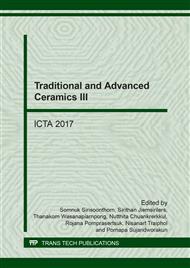[1]
E. Comini, Metal oxide nanowire chemical sensors: innovation and quality of life, Materials Today, 19 (2016) 559-567.
DOI: 10.1016/j.mattod.2016.05.016
Google Scholar
[2]
X. Gou, G. Wang, J. Yang, J. Park, D. Wexler, Chemical synthesis, characterisation and gas sensing performance of copper oxide nanoribbons, Journal of Materials Chemistry, 18 (2008) 965-969.
DOI: 10.1039/b716745h
Google Scholar
[3]
F. Riboni, N.T. Nguyen, S. So, P. Schmuki, Aligned metal oxide nanotube arrays: key-aspects of anodic TiO2 nanotube formation and properties, Nanoscale Horizons, 1 (2016) 445-466.
DOI: 10.1039/c6nh00054a
Google Scholar
[4]
H. Kloust, R. Zierold, J.-P. Merkl, C. Schmidtke, A. Feld, E. Pöselt, A. Kornowski, K. Nielsch, H. Weller, Synthesis of Iron Oxide Nanorods Using a Template Mediated Approach, Chemistry of Materials, 27 (2015) 4914-4917.
DOI: 10.1021/acs.chemmater.5b00513
Google Scholar
[5]
P.M. Rao, X. Zheng, Rapid Catalyst-Free Flame Synthesis of Dense, Aligned α-Fe2O3 Nanoflake and CuO Nanoneedle Arrays, Nano Letters, 9 (2009) 3001-3006.
DOI: 10.1021/nl901426t
Google Scholar
[6]
L.V. Thong, L.T.N. Loan, N. Van Hieu, Comparative study of gas sensor performance of SnO2 nanowires and their hierarchical nanostructures, Sensors and Actuators B: Chemical, 150 (2010) 112-119.
DOI: 10.1016/j.snb.2010.07.033
Google Scholar
[7]
T. Zhai, X. Fang, M. Liao, X. Xu, H. Zeng, B. Yoshio, D. Golberg, A Comprehensive Review of One-Dimensional Metal-Oxide Nanostructure Photodetectors, Sensors, 9 (2009) 6504.
DOI: 10.3390/s90806504
Google Scholar
[8]
R.S. Devan, S.-Y. Gao, W.-D. Ho, J.-H. Lin, Y.-R. Ma, P.S. Patil, Y. Liou, Electrochromic properties of large-area and high-density arrays of transparent one-dimensional β-Ta2O5 nanorods on indium-tin-oxide thin-films, Applied Physics Letters, 98 (2011).
DOI: 10.1063/1.3568896
Google Scholar
[9]
S.-Y. Kuo, H.-I. Lin, Field emission characteristics of zinc oxide nanowires synthesized by vapor-solid process, Nanoscale Research Letters, 9 (2014) 70-70.
DOI: 10.1186/1556-276x-9-70
Google Scholar
[10]
R. Pietruszka, B.S. Witkowski, S. Gieraltowska, P. Caban, L. Wachnicki, E. Zielony, K. Gwozdz, P. Bieganski, E. Placzek-Popko, M. Godlewski, New efficient solar cell structures based on zinc oxide nanorods, Solar Energy Materials and Solar Cells, 143 (2015).
DOI: 10.1016/j.solmat.2015.06.042
Google Scholar
[11]
Y. Li, X.-Y. Yang, Y. Feng, Z.-Y. Yuan, B.-L. Su, One-Dimensional Metal Oxide Nanotubes, Nanowires, Nanoribbons, and Nanorods: Synthesis, Characterizations, Properties and Applications, Critical Reviews in Solid State and Materials Sciences, 37 (2012).
DOI: 10.1080/10408436.2011.606512
Google Scholar
[12]
M.Z.H. Khan, M.R. Al-Mamun, P.K. Halder, M.A. Aziz, Performance improvement of modified dye-sensitized solar cells, Renewable and Sustainable Energy Reviews, 71 (2017) 602-617.
DOI: 10.1016/j.rser.2016.12.087
Google Scholar
[13]
R. Liu, Z. Sun, Y. Zhang, L. Xu, N. Li, Polyoxometalate-modified TiO2 nanotube arrays photoanode materials for enhanced dye-sensitized solar cells, Journal of Physics and Chemistry of Solids, 109 (2017) 64-69.
DOI: 10.1016/j.jpcs.2017.05.018
Google Scholar
[14]
S.K. Balasingam, M.G. Kang, Y. Jun, Metal substrate based electrodes for flexible dye-sensitized solar cells: fabrication methods, progress and challenges, Chemical Communications, 49 (2013) 11457-11475.
DOI: 10.1039/c3cc46224b
Google Scholar
[15]
S. Gubbala, H.B. Russell, H. Shah, B. Deb, J. Jasinski, H. Rypkema, M.K. Sunkara, Surface properties of SnO2 nanowires for enhanced performance with dye-sensitized solar cells, Energy & Environmental Science, 2 (2009) 1302-1309.
DOI: 10.1039/b910174h
Google Scholar
[16]
D. Barpuzary, A.S. Patra, J.V. Vaghasiya, B.G. Solanki, S.S. Soni, M. Qureshi, Highly Efficient One-Dimensional ZnO Nanowire-Based Dye-Sensitized Solar Cell Using a Metal-Free, D−π−A-Type, Carbazole Derivative with More than 5% Power Conversion, ACS Applied Materials & Interfaces, 6 (2014).
DOI: 10.1021/am5026193
Google Scholar
[17]
J. Fan, Z. Li, W. Zhou, Y. Miao, Y. Zhang, J. Hu, G. Shao, Dye-sensitized solar cells based on TiO2 nanoparticles/nanobelts double-layered film with improved photovoltaic performance, Applied Surface Science, 319 (2014) 75-82.
DOI: 10.1016/j.apsusc.2014.07.054
Google Scholar
[18]
P. Hiralal, S. Saremi-Yarahmadi, B.C. Bayer, H. Wang, S. Hofmann, K.G. Upul Wijayantha, G.A.J. Amaratunga, Nanostructured hematite photoelectrochemical electrodes prepared by the low temperature thermal oxidation of iron, Solar Energy Materials and Solar Cells, 95 (2011).
DOI: 10.1016/j.solmat.2011.01.049
Google Scholar
[19]
S.M. Bergin, Y.-H. Chen, A.R. Rathmell, P. Charbonneau, Z.-Y. Li, B.J. Wiley, The effect of nanowire length and diameter on the properties of transparent, conducting nanowire films, Nanoscale, 4 (2012) 1996-(2004).
DOI: 10.1039/c2nr30126a
Google Scholar
[20]
H. Niu, S. Zhang, Q. Ma, S. Qin, L. Wan, J. Xu, S. Miao, Dye-sensitized solar cells based on flower-shaped a-Fe2O3 as a photoanode and reduced graphene oxide-polyaniline composite as a counter electrode, RSC Advances, 3 (2013) 17228-17235.
DOI: 10.1039/c3ra42214c
Google Scholar
[21]
N.M. Rashid, N. Kishi, T. Soga, Effects of nanostructures on iron oxide based dye sensitized solar cells fabricated on iron foils, Materials Research Bulletin, 77 (2016) 126-130.
DOI: 10.1016/j.materresbull.2016.01.028
Google Scholar
[22]
K. Hongsith, N. Hongsith, D. Wongratanaphisan, A. Gardchareon, S. Phadungdhitidhada, P. Singjai, S. Choopun, Sparking deposited ZnO nanoparticles as double-layered photoelectrode in ZnO dye-sensitized solar cell, Thin Solid Films, 539 (2013).
DOI: 10.1016/j.tsf.2013.04.150
Google Scholar


